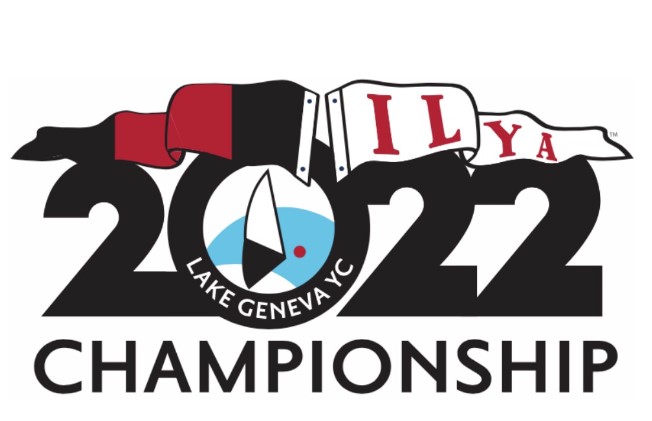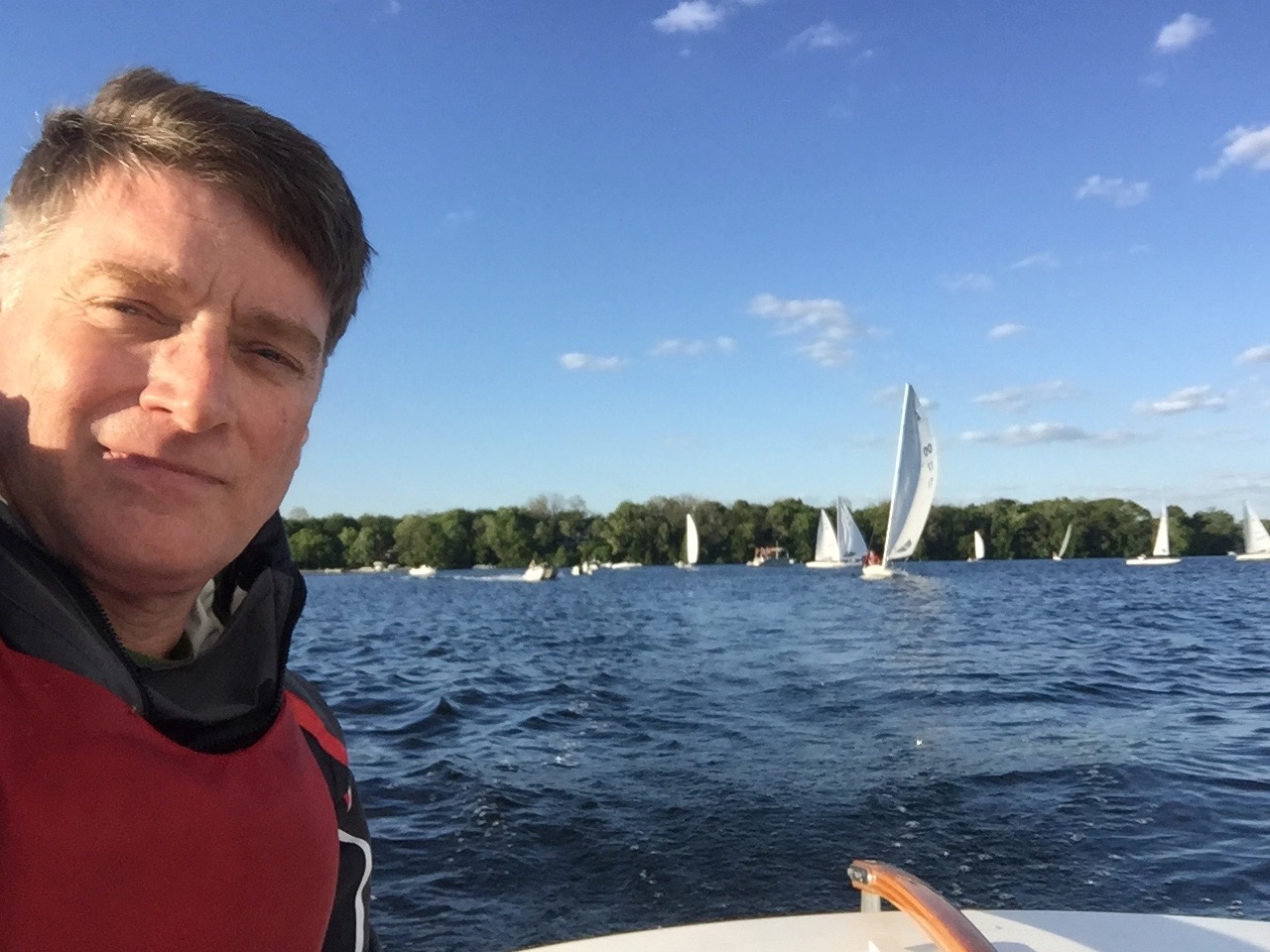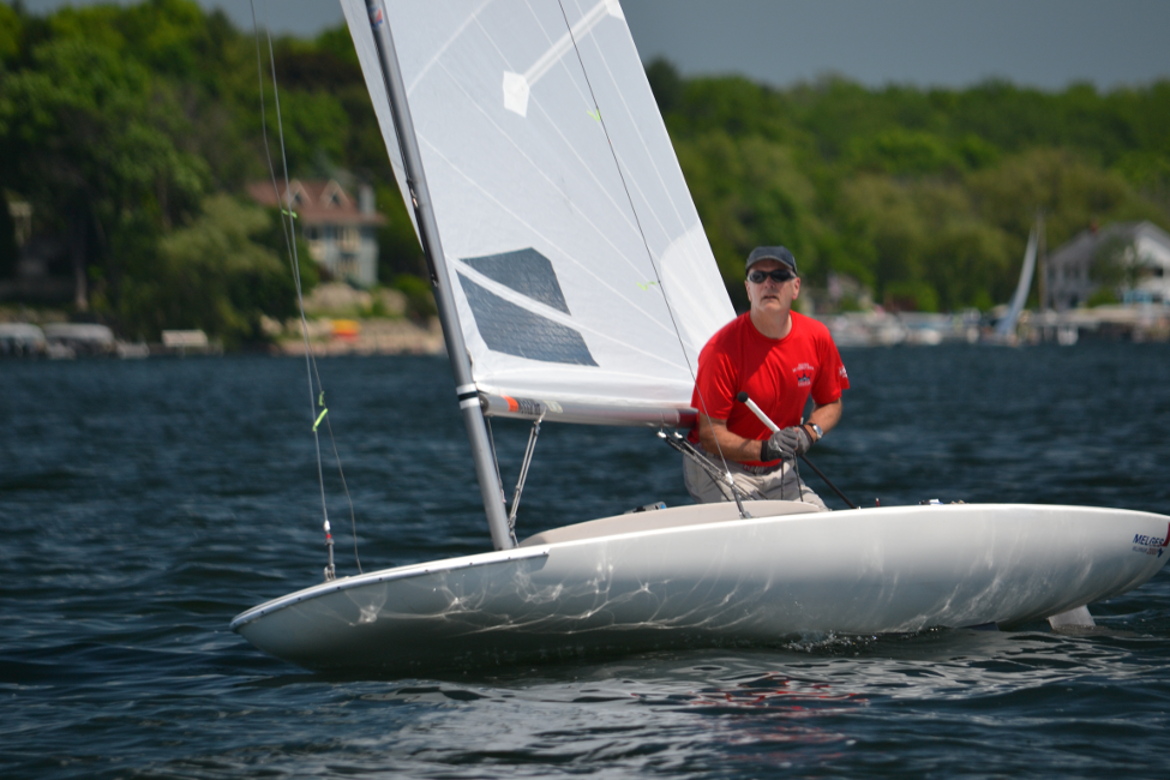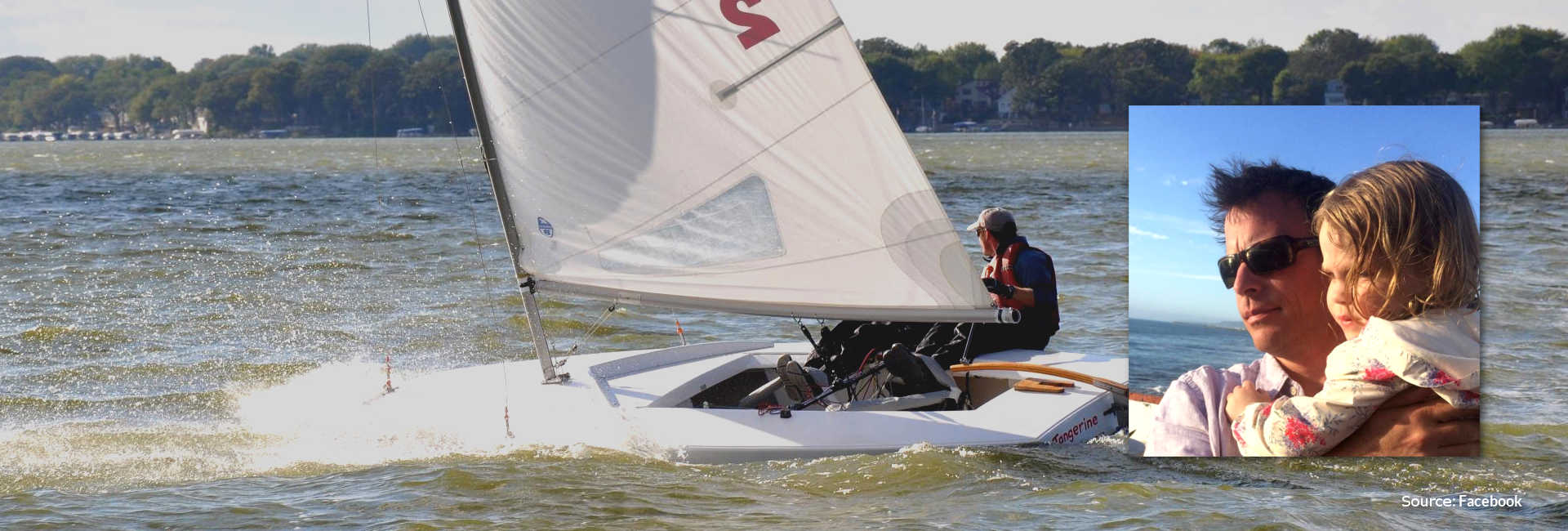The 2022 ILYA Championship were held August 18-21 at Lake Geneva, WI. Approximately 200 boats raced in four classes – A Scow, E Scow, C Scow, and MC Scow. We caught up with the top performers in the E and MC classes:
- Allan Terhune – Allan won the MC class in a three-way tie, with two first place finishes.
- Jeff Bonanni, Eric Doyle, and Allan Terhune – winning E Scow team.
- Marek Valasek – tied for first in the MC class and winner of Race 1.
- Bill Draheim – tied for first in the MC class.
- Mike Considine – winner of race 4 in the MC class.
Allan, Jeff, and Eric provided the debrief in a North Sails webinar – ILYA Championship Debrief. We interviewed the others separately and compiled the collective thoughts on boat speed, starting, and upwind strategy.
Boat Speed
Angle of heel is critical
- Don’t wait to get weight in and power up as wind decreases. If you let the boat go flat, you’ll slow the boat even more, forcing you to bear off to regain speed. (Allan and Jeff)
- In unsettled water increase the heel slightly to cut through the waves. Otherwise, you may find the bow slapping into the waves and pushing water forward, which is slow. (Jeff and Allan).
Depowering Sequence – MC
- In marginal hiking conditions Allan uses the outhaul first to power up and depower.
- Bill drops traveler and sheets very hard. The mainsheet tension tightens the leech to bend the mast uniformly and flatten the entire sail. On puffy days this requires big eases on the mainsheet. He uses less vang than other sailors since the vang primarily bends the bottom half of the mast, and Bill feels that too much vang leaves the leech too tight when easing.
- Allan sometimes uses traveler sheeting, keeping the mainsheet tight and playing the traveler in puffs. However, on day 2 (windy and with sharp puffs), he found he needed to set the traveler and vang sheet.
- Marek uses traveler sheeting with minimal or no vang until the traveler gets too far down. Then he brings the traveler back toward center, tightens the vang, and vang sheets.
- He likes this approach because traveler sheeting preserves the sail shape. However, if the traveler gets too far down, this approach becomes risky, since you may not be able to ease the traveler enough.
- He doesn’t play the outhaul much but uses some cunningham tension when hiking and more cunningham tension when vang sheeting.
- Mike uses vang sheeting. He uses helm feel as a guide to how much vang to use. When the breeze builds further, he adds more vang and drops the traveler. He also uses the cunningham in breeze to help bend the mast and open the upper leech. He doesn’t play the outhaul much.
E Scow Boat Speed – Jeff Bonanni
- Jeff is very particular about following the tuning guide. He uses the updated North tuning guide for E Scows with the M3 main and J4 jib.
- He feels that jib adjustments during the race are critical (tack height, clew board, and jib track position).
- He looks for overbend wrinkles in the lower half of the sail as a guide to determining optimal mast bend. Overbend wrinkles indicate you are at max vang for the conditions.
Starting
On the MC courses, sailors were setting up too early and too close to the line. Besides delaying the race with numerous recalls, setting up too close leaves you no runway to accelerate, especially in lighter air.
- Allan tries to keep some forward speed in the approach
- Forward speed is essential for maneuvering and bearing off to accelerate.
- Allan saw many sailors trying to bear off and sheet in at the same time. Best technique is to bear off before sheeting in. Otherwise, the boat will want to round up.
- One technique is to sail high and slow during the approach to maintain a gap to leeward. Allan keeps both boards down until just before it’s time to bear off and accelerate.
- Marek is very active at positioning in the pre-start.
- Reposition as needed until one minute or so to find a clear spot.
- Defend aggressively, scooping down and heading up to maintain some speed and height.
- In the E scow with instruments, Jeff relies on the forward crew to call distance to line, while Jeff keeps track of the time. This is less confusing than having the forward crew call both time and distance. The forward crew will also communicate situations that require accelerating early.
Strategy
On the MC courses, the puffs were coming from the left side most of the time, with an occasional right-hand shift. The left side of the starting line was more crowded. Regardless of where they started, many sailors worked hard to get left after the start. The winners shared their thoughts on strategy in this kind of situation.
Starting location
- Jeff remarked that if you have good boat speed you can sail more conservatively and don’t have to take risks trying to win the favored end.
- Mike fought hard for the pin in most races. He finished first in the last race, when he won the pin end and was able to tack to port and sail in clear air. However, this didn’t work as well in some other races, when he couldn’t tack to the lifted port tack due to the number of boats remaining on starboard. He also got forced over early by a boat that got to leeward of him just before the start.
- Marek noted that in the first race the windward mark was placed very far to the right. Marek intentionally started middle left and was laying the mark when the big left pressure came in. Those further left were overstood and sailed extra distance.
- Allan says he spent most of the pre-start looking upwind to find the pressure and used that to guide his starting location.
Upwind Strategy
The wind velocity variations were significant. All the top sailors agreed that the key was getting into pressure.
- All agreed that you had to favor the left side. That didn’t mean that you needed to get there right away. With patience, you were likely to find an opportunity a way to get further left. Marek believes that only 65-75% of the pressure was from the left.
- Bill pointed out that many sailors were reluctant to sail on the lifted port tack in good pressure and would tack back to starboard rather than duck a starboard boat. He counsels patience to find the right opportunity to get back left.
- Marek’s rule of thumb is to look for both pressure and a decent angle to get back. If you get desperate, at least wait for good pressure. He felt that it was more important to be left near the top of the course, so as the series went on, he prioritized working his way left as the leg progressed.
- Allan put it this way: if you’re sailing on starboard in a puff, decide if there is more wind ahead. If so, keep going, even if the angle isn’t great. If not, tack to the lifted port tack.
- Some sailors found a way to get back left by taking the “unfavored” course right gate (looking upwind). It turns out there were some right-hand shifts near the right shore. Taking the unfavored gate also lets you round directly onto the lifted (port) tack. Those that took the course left gate had to sail a header in disturbed air to find a clear lane.
Related Content
Quantum/Melges E Scow Tuning Guide
North Sails E Scow Tuning Guide 2022
Sailing Upwind by Constant Angle of Heel
Seven Depowering Tools
Where to Start – SailZing Tag Results
Upwind Strategy – SailZing Tag Results





